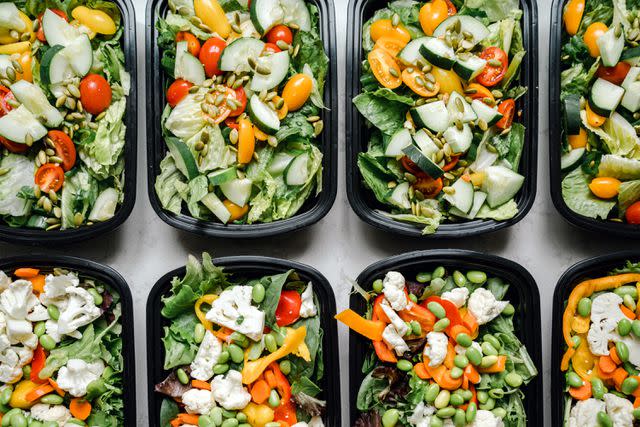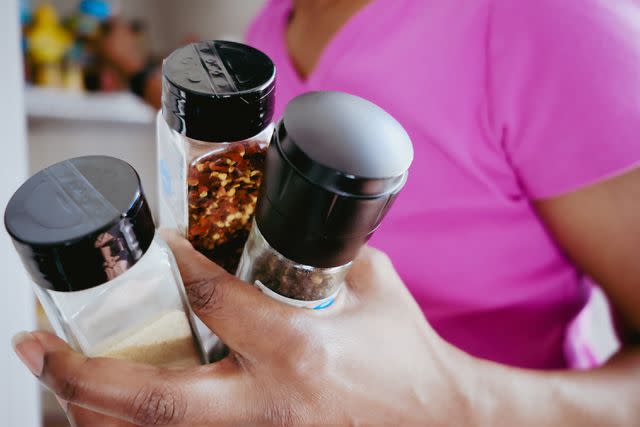Meal Planning Made Simple: How to *Actually* Meal Prep, According to a Dietitian
It's never as easy as TikTok makes it look — but these expert tips can make meal prep less of a chore.

Getty Images
I am a huge fan of The Container Store. Just stepping into one of their retail shops brings my stress level down several notches. I love that in-control feeling when my house is organized (which never lasts long with three kids and a dog) and perfectly tidied up.
So here's my hot take: Meal prepping is the nutritional equivalent of Marie Kondo-ing your home. Done right, meal prepping can make you an organized machine that is set up for success and satisfaction with your meals—all week long.
Gazing at those stacks of loaded jars and food containers on Instagram, meal prep seems so easy. In reality, it does take a fair amount of time, space, organization, and creativity to pull off. But once you've mastered it, the benefits are substantial. We asked a dietitian to share her best meal planning tips so that you can master these weekly to-do, once and for all.
Understanding the Benefits of Meal Planning and Prep
You already know that meal prep will help you eat healthier, but you may not quite understand why that's the case. According to Dawn Jackson Blatner, RDN and author of The Superfood Swap, people who meal prep improve the way they eat because, "When you plan ahead, you tend to make better choices than when you're running around last minute." And those smart choices can lead to filling in nutritional gaps with foods we know we should be getting more of. Planning meals will lead to more balanced meals says Samantha Cassetty, MS, RD, plant-forward nutrition and wellness expert and co-author of Sugar Shock. "About 90 percent of adults don't meet fruit and veggie targets, and planning can help you get closer to— or meet— your goals," she says.
What's more, meal planning can help you significantly slash both food waste and your ever-growing grocery bill. When your dinner is already prepped and waiting for you in the fridge, the temptation to DoorDash sushi is greatly diminished. And, since you've planned how you'll use those ingredients you bought, "less food will go to waste, which is a plus for the environment," points out Cassetty.
Let's not forget possibly the biggest savings that come from prepping your meals: stress. That's right, you'll have less of the thing that is keeping you up at night and contributing to those fine lines on your forehead. Blatner believes that eliminating decision fatigue around food is key to reducing stress, stating, "Your world flows better when your food life is planned in advance!" Amen, sister.
If you're trying to achieve a specific nutrition or health-related goal, it's time to jump on the prep train. Say you want to hit that elusive daily fiber goal of 25 to 30 grams. That means that each meal and snack needs to contribute between 5 to 6 grams of fiber. Unless you've got a plan in place with specific foods at the ready, the likelihood of achieving that fiber goal is slim to none. The same can be said if you're attempting to add more protein to your diet, reduce sugar, or follow a Mediterranean-style pattern of eating. The framework of a plan can help you grasp those goals.

Stocksy
Setting Realistic Goals and Identifying Needs
Speaking of goals, is it possible to meal prep without feeling like you're taking on a second job? Nutrition clients often ask me if they really need to prepare each and every meal and snack each week. Thankfully, the answer is absolutely not. While social media may convince you that everyone is prepping every bite that graces their lips, in truth, that's just not achievable.
Blatner teaches something called "2-4-2 meal planning." In this system, she recommends prepping 2 breakfasts, 4 dinners, and 2 snacks, with lunch being leftovers from dinner that can be served over greens or in a wrap or bowl. Her clients find that they have enough variety to be satisfied, but it's not so much work that they're overwhelmed. Cassetty does something similar with her "mix and match" approach, which includes prepping a total of 6 meals and then filling in with items that are easy to throw together, like yogurt and berries.
Planning the Menu
At this point, you may want to just run to Trader Joe's and start loading up your cart with ingredients. But back up a minute—you need a menu first. Whether you jot down your menu in a journal or use the Notes app on your phone, it's wise to keep track of the date and which recipes you plan to make. That way, you can quickly locate them if you'd like to make them again. In terms of the mix of recipes you'll be making, it requires a bit of advanced planning.
It's smart to think about the week ahead and the types of food that will support your lifestyle. Are you looking for a breakfast you can eat before your morning Peloton sesh or something you'll be noshing on alongside your toddler? Will some lunches be eaten at your desk in the office and others at home? You'll also want to think about any work dinners or lunches you plan to eat at restaurants and consider those meals so that you don't waste food.
If you're thinking about that 2-4-2 formula, that could translate to a menu that looks like this:
Breakfast: overnight oats and a smoothie that you'll make a few times
Dinner: pasta primavera, sheet pan salmon, crispy tofu tacos, and skillet shrimp
Snacks: energy balls and hard-boiled eggs
Creating a Grocery List
Once you've settled on your recipes for the week, it's time to shop! It's smart to make a digital list that includes all the ingredients you'll need. This way you can avoid buying multiples of the same ingredient and can flag anything that you already have on hand. You can keep this list on your phone, use an app, or go old school and print it out and check items off as you put them in your cart.
If you shop for groceries online, your delivery service, such as Fresh Direct or Amazon Fresh, will likely have a list of your favorite items that makes it easy to reorder things you use frequently.
Prepping and Batch Cooking
Efficiency is key when it comes to the time you spend in the kitchen. And batch cooking—or cooking multiple servings at a time—is a smart way to knock out the base of several meals at once. For example, if you make quinoa, you can enjoy it as the base of a grain bowl for two nights, then repurpose it to serve with sheet-pan veggies and tofu to create another meal. Instant Pots, slow cookers, and rice cookers can be a big help with making grains because you don't need to babysit them.
In addition to being a superfood, eggs are also a meal prep all-star. You can make a bunch of hard-boiled eggs to last all week or make egg cups for on-the-go breakfasts. And, once you pull out that cutting board, put it to good use. Cassetty shares that she preps multiple veggies in a row, which saves her big time throughout the week.
Related: 10 TikTok Food Hacks That Actually Work
Storage and Food Safety
Once your food is cooked, you'll want to divvy it up to make it easy to grab and go on your way to work or school, or simply to enjoy in your kitchen. And storing food properly will ensure that it's safe until you're ready to enjoy it. Cooked food should be stored in airtight containers in the refrigerator within two hours of cooking it.
As with any food handling, the number one thing you can do to keep food safe is to wash your hands before touching anything. And if you're cooking raw meat, poultry, or shellfish, you'll want to wash your hands before preparing foods that will be eaten raw (such as veggies and fruit) to avoid cross-contamination.
According to the USDA, hot food should be transferred to shallow storage containers and placed in the refrigerator or freezer to cool down. Prepared food should be reheated to 165°F and eaten within three to four days. If you don't think you'll be able to enjoy your meals in that amount of time, you can freeze them.
Meal Prepping for Specific Dietary Needs
If you're meal prepping for yourself and others, it's smart to make sure that the base ingredient, such as pasta, oats, or other grain, works with everyone's diet, such as gluten-free. My oldest daughter has several food allergies and is also a pescatarian, so I know that there are certain meals that I'll need to prepare separately for her. If I'm making pasta, I will always save the pasta separately from the sauce to make sure she can still enjoy it later in the week.
And if you like cheese or chopped nuts on top of your dish, you can add them right before serving. If one of your family or housemates follows a low-carb diet, you can still make dishes that include grains, but just keep them separate from the protein you're cooking. It may help to use containers with different colored lids to identify the food that is for the person with the specific dietary need.
Maximizing Versatility and Variety
One complaint that I've heard from friends and clients is that their meal prep game starts off strong, but by the end of the week, they're bored to tears. If that sounds familiar, it's time to up your condiment game. Instead of spending additional time making sauces and marinades from scratch, Blatner approves buying products that are lower in sodium and/or have low or no added sugar. Use high-quality oils like olive and avocado, such as the ones from Primal Kitchen and Sir Kensington's. Cassetty beats boredom with spices such as sumac, chili lime, curry powder, and taco seasoning.
Once you have these flavor bombs at your fingertips, you'll be able to take ingredients from Mexican flavors one night to Greek or West African the next. It may take some time, but you'll learn which ingredients are most flexible for you and the way you like to eat.

Getty Images
Overcoming Common Challenges and Staying Motivated
Staying in the game is half the battle when it comes to any type of new habit. And sometimes you need a little incentive to help you keep at it. Just like a new workout outfit can help you stick to your morning HIIT routine, a new cooking tool (hello pizza oven!), recipe, or cookbook may be just what you need to fight meal prep fatigue.
If you feel overwhelmed by the time that's involved, call in the troops! Ask your partner, roommate, or kid to help with the prep. That can include chopping veggies or finding fabulous recipes online. If you need some more inspiration, check out recipes and plan meals via apps like Mealime and MealBoard.
Related: The Best Meal Planning Apps for Meeting Your Healthy Eating Goals
Long-Term Meal Planning Habits and Adaptability
If the end of the week rolls around and you're chucking uneaten meals in the compost bin, try scaling back. Instead of making four dinners, cook two instead. You can also whip up something simple, like an omelet if you need to fill in the gaps. A little flexibility can go a long way toward helping you meet your goals. Meal prep shouldn't feel like an all-or-nothing endeavor. And as Blatner says, "You don't need to be an A student every week."
Related: The 7-Day Diet Plan for Weight Loss
For more Shape news, make sure to sign up for our newsletter!
Read the original article on Shape.

